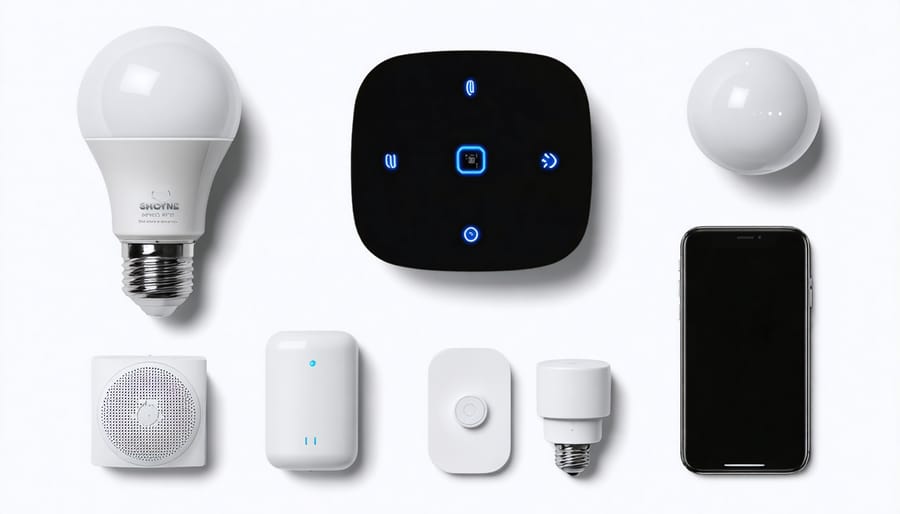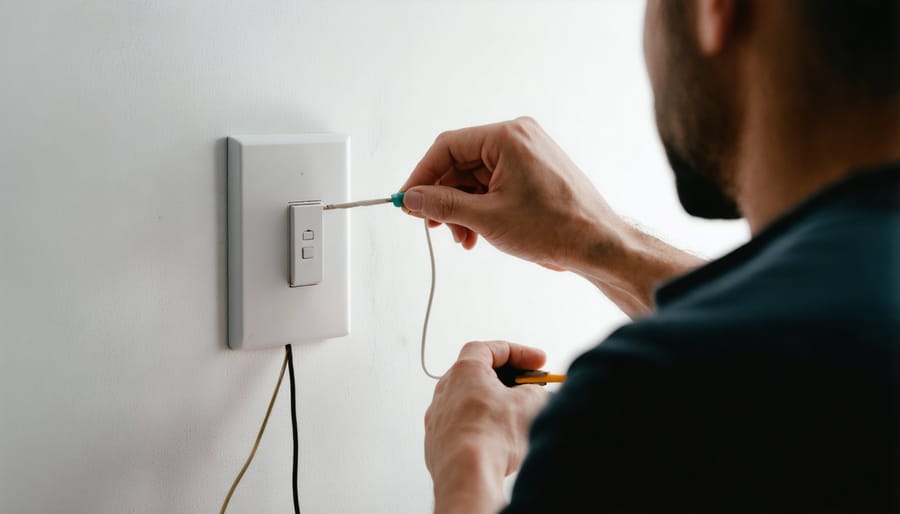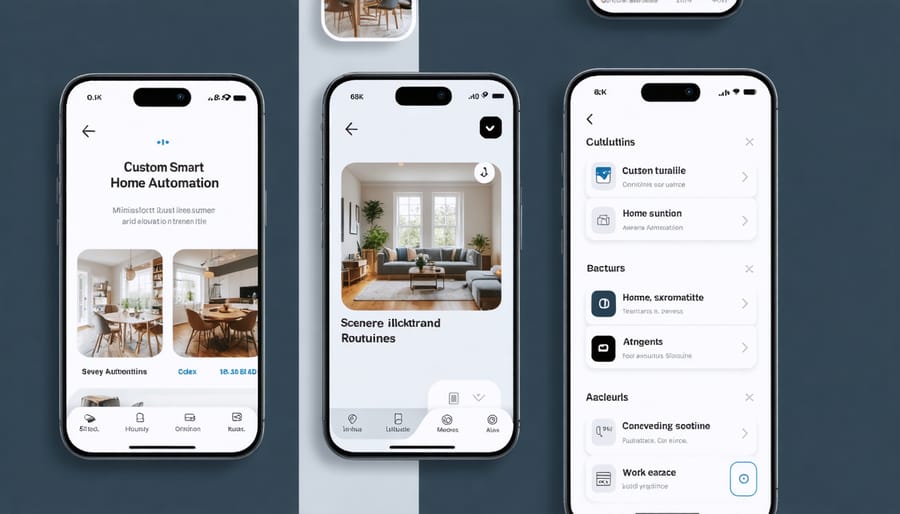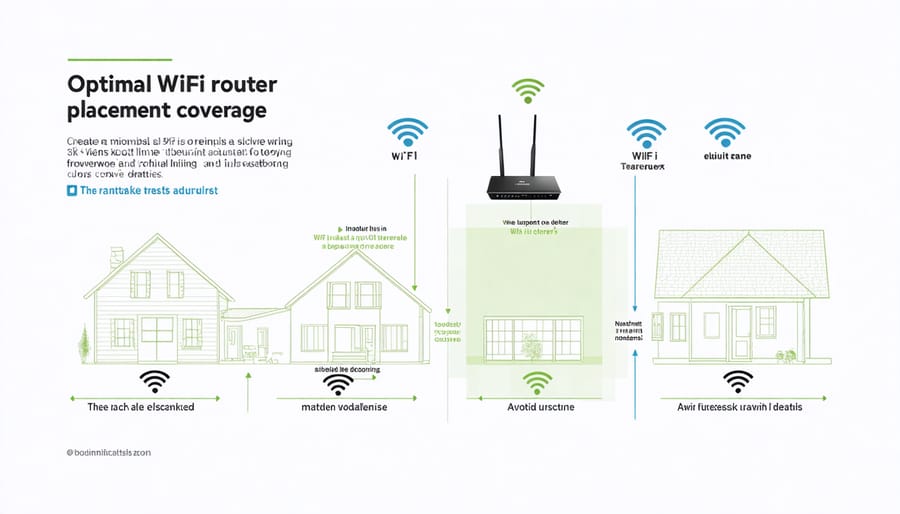Transform your home into an automated sanctuary with today’s intelligent technology systems. Smart home automation isn’t just about convenience—it’s about creating a living environment that anticipates your needs, enhances security, and helps manage energy consumption efficiently. From voice-controlled lighting to automated climate control, the right smart home setup can transform your living space into a modern marvel of efficiency and comfort.
Installing a smart home system requires careful planning and strategic implementation, but the benefits far outweigh the initial setup effort. Whether you’re starting with a single smart device or planning a comprehensive home automation system, this guide will walk you through the essential steps to create a connected home that works seamlessly with your lifestyle. We’ll cover everything from selecting compatible devices and establishing a reliable network infrastructure to programming automated routines and ensuring your system’s security.
Get ready to embrace the future of home living with our comprehensive installation guide that makes smart home automation accessible to everyone, regardless of technical expertise.
Planning Your Smart Home Setup
Assessing Your Home’s Infrastructure
Before diving into smart home automation, it’s crucial to optimize your home’s infrastructure to ensure a smooth installation process. Start by examining your home’s electrical system. Most smart devices require consistent power and sometimes neutral wires, which older homes might lack. Check your electrical outlets and switches, noting their locations and conditions.
Next, evaluate your WiFi network’s coverage and strength. A robust wireless connection is the backbone of any smart home system. Use your smartphone to conduct a simple WiFi speed test in different rooms, paying special attention to areas where you plan to install smart devices. Consider adding WiFi extenders or mesh networks if you discover dead zones.
Compatibility is another crucial factor. Make a list of your existing devices and appliances, checking whether they can integrate with smart home systems. Look for devices with common protocols like WiFi, Zigbee, or Z-Wave. Don’t forget to assess your current internet plan – smart homes typically need at least 50 Mbps download speeds for optimal performance.
Finally, document your home’s layout, marking potential mounting locations for hubs, cameras, and sensors. Consider factors like power source proximity, line of sight for devices that need to communicate, and physical obstacles that might interfere with signals. This preparation will save you time and frustration during the actual installation process.
Choosing the Right Smart Home Ecosystem
Choosing the right ecosystem is like picking the foundation for your smart home – it’s a decision that will shape your entire automation experience. Let’s explore the three major platforms to help you make an informed choice.
Google Home offers excellent voice recognition and seamless integration with Android devices and Chrome-based products. If you’re already using Google services like Calendar and Maps, this ecosystem will feel natural. Google’s platform particularly shines in its search capabilities and ability to answer complex questions.
Apple HomeKit stands out for its robust security features and smooth integration with iOS devices. While it may have fewer compatible devices compared to other platforms, HomeKit offers unmatched privacy protection and a highly intuitive interface. If you’re an iPhone user who values security, this might be your best bet.
Amazon Alexa leads the pack in device compatibility and third-party integrations. With the widest selection of compatible smart devices and skills, Alexa is incredibly versatile. The platform excels in shopping features and entertainment options, making it perfect for families who frequently use Amazon services.
Consider these factors when choosing:
– Which smartphones and tablets you currently use
– Your budget (some ecosystems require specific hubs)
– The smart devices you already own or plan to buy
– Your privacy preferences
– How comfortable you are with technology
Remember, you’re not strictly limited to one ecosystem – many modern smart devices work with multiple platforms, giving you flexibility as your needs evolve.

Essential Smart Home Components
Smart Hub Installation
The smart hub serves as the brain of your home automation system, so choosing the right location and setting it up correctly is crucial. Start by selecting a central location in your home, ideally near your router, as most hubs require a stable internet connection. Avoid placing it near large metal objects or inside cabinets, which can interfere with wireless signals.
Before powering up your hub, download the manufacturer’s app to your smartphone – this will guide you through the setup process. Most modern hubs use simple plug-and-play installation: connect the hub to power, then to your router using an ethernet cable. Once powered on, the app will typically detect your hub automatically.
During setup, you’ll need to create an account and connect the hub to your home’s Wi-Fi network. This is also the perfect time to name your hub and set up different rooms or zones in your home. Take a few minutes to familiarize yourself with the app’s interface and basic functions.
Pro tip: Write down your hub’s login credentials and keep them in a secure place. Also, make sure to enable any security features offered, such as two-factor authentication, to protect your smart home system from unauthorized access.
Once your hub is online, test the connection by walking around your home with your smartphone. If you notice any dead spots, you might need to relocate the hub or consider adding a Wi-Fi extender to ensure reliable coverage throughout your space.
Lighting and Switch Installation
Transforming your home’s lighting into a smart system is one of the most impactful ways to begin your automation journey. Start by identifying which lights you want to convert – popular choices include living room lamps, outdoor lighting, and frequently used fixtures.
For the simplest installation, smart bulbs are your best bet. Simply unscrew your existing bulbs and replace them with smart alternatives. Most smart bulbs connect directly to your home’s WiFi network through a companion app, making setup a breeze. Remember to keep your old bulbs as backups!
If you’re comfortable with basic electrical work, smart switches offer more flexibility and work with any bulb type. Before installation, always turn off power at the circuit breaker – safety first! Remove your old switch’s faceplate and note the wire connections. Most smart switches require a neutral wire (usually white), so check if your electrical box has one before purchasing.
For dimming capabilities, smart dimmers provide smooth light control and can often be programmed with favorite lighting scenes. Install them just like smart switches, but ensure your bulbs are dimmer-compatible to avoid flickering issues.
Pro tip: Create a lighting diagram before you start, marking which switches control which fixtures. This will help you organize your smart lighting zones and create more intuitive automation routines later on.
Finally, test each new installation thoroughly before moving to the next. Most smart lights can be grouped together in their apps, allowing you to control multiple fixtures simultaneously or create coordinated lighting scenes for different occasions.

Security Device Setup
Installing security devices is a crucial step in creating a smart, secure home. Start with a comprehensive smart security installation plan that covers all entry points and vulnerable areas of your home.
Begin with smart cameras, positioning them at key locations like your front door, backyard, and garage. Mount them at a height of 8-10 feet for optimal coverage while keeping them out of reach. Most modern smart cameras connect via Wi-Fi and include features like motion detection, night vision, and two-way audio.
Next, install smart locks on your exterior doors. Remember to keep the existing deadbolt if the smart lock doesn’t include one. Most smart locks attach easily to standard door preparations, making them a straightforward DIY project. Just ensure your door is properly aligned before installation to avoid functionality issues.
Motion sensors and door/window sensors complete your security setup. Place motion sensors in corners at about 6-7 feet high, avoiding areas with direct sunlight or heating vents. Install door/window sensors on the frame and moving part of each entry point, ensuring they align properly when closed.
Don’t forget to test each device thoroughly after installation. Connect all devices to your home’s network and ensure they communicate properly with your smart hub or smartphone app. Regular maintenance, including checking batteries and cleaning camera lenses, will keep your security system running smoothly.
Advanced Automation Features
Creating Custom Scenes
Creating custom scenes is where your smart home truly becomes personalized to your lifestyle. Think of scenes as pre-programmed routines that coordinate multiple devices to create the perfect atmosphere for different activities or times of day. Start with basic scenes like “Good Morning,” which could gradually raise your blinds, adjust the thermostat, and activate smart lighting automation to help you wake up naturally.
Consider creating an “Away” scene that secures your home by arming security systems, turning off unnecessary devices, and setting lights to randomly turn on and off to simulate occupancy. For movie nights, program a “Cinema” scene that dims the lights, lowers the blinds, and sets your TV to the perfect viewing mode.
Most smart home apps make scene creation intuitive with drag-and-drop interfaces. Start by selecting the devices you want to include, then specify their desired states or actions. You can also set triggers like specific times, voice commands, or location-based activation.
Pro tip: Begin with simple scenes and gradually add complexity as you become more comfortable with your system. Test each scene thoroughly before relying on it, and don’t forget to create backup commands for essential functions in case your automated routines encounter any hiccups.

Voice Control Integration
Voice control is one of the most convenient features of a smart home system, allowing you to manage your devices hands-free. To get started, choose a primary voice assistant platform like Amazon Alexa, Google Assistant, or Apple Siri based on your existing devices and preferences.
Begin by placing your smart speakers or displays strategically throughout your home, ensuring good coverage in high-traffic areas like the kitchen, living room, and bedroom. Position them away from noise sources and walls for optimal performance. Once placed, connect them to your home’s Wi-Fi network and download the corresponding app.
Next, link your smart devices to your chosen voice assistant through the app. Most modern smart devices are compatible with multiple platforms, but double-check compatibility before purchasing. Create meaningful device names and organize them into rooms or groups for easier control. For example, “kitchen lights” is more intuitive than “light 1.”
Customize your voice commands by setting up routines that trigger multiple actions with a single phrase. A “good morning” routine might gradually turn on lights, adjust the thermostat, and play your favorite news briefing. Start with basic commands and gradually expand as you become more comfortable.
Pro tip: Keep your voice commands simple and consistent. Using natural language like “turn on the living room lights” works better than complex phrases. Remember to speak clearly and face the device when giving commands for the best response.
Mobile App Configuration
Once your smart home devices are installed, it’s time to set up your mobile command center. Start by downloading your hub’s official app from your device’s app store. Most major platforms like Samsung SmartThings, Apple HomeKit, or Google Home offer user-friendly apps that guide you through the setup process.
Create a secure account using a strong password and enable two-factor authentication for added security. This extra step helps protect your home’s automated systems from unauthorized access. Once logged in, follow the app’s prompts to connect to your hub, typically by scanning a QR code or entering a unique identifier.
Now comes the fun part – adding your devices! Most apps will automatically detect new smart devices on your network. Name each device clearly (like “Living Room Lights” or “Front Door Camera”) to make voice commands and routines easier to manage later.
Take time to explore your app’s features. Set up rooms and zones to group related devices, create custom scenes for different activities (like “Movie Night” or “Good Morning”), and configure automation rules. Many apps also allow you to share access with family members while maintaining different permission levels.
Don’t forget to test your remote access by turning off Wi-Fi and using cellular data. This ensures you can control your home even when you’re away. Keep your app updated to access new features and security improvements as they become available.
Troubleshooting and Maintenance
Network Optimization
A reliable network is the backbone of any smart home system. To ensure your devices work seamlessly together, start by positioning your router in a central location, away from metal objects and thick walls that can block signals. If you’re dealing with a larger home, consider adding mesh WiFi nodes to extend coverage to every corner.
To minimize interference, keep your router away from other electronic devices, especially microwave ovens and cordless phones that operate on the 2.4GHz frequency. Most modern routers offer both 2.4GHz and 5GHz bands – use 5GHz for devices that need faster speeds and are closer to the router, while 2.4GHz is better for devices farther away or those that don’t require high bandwidth.
Create a dedicated network for your smart home devices to improve security and prevent them from competing with other devices for bandwidth. Many routers allow you to set up a guest network, which is perfect for this purpose. Remember to regularly update your router’s firmware to ensure optimal performance and security.
If you’re experiencing connectivity issues, try changing your router’s channel settings. Most routers automatically select channels, but manual selection can help avoid interference from neighboring networks. Use a WiFi analyzer app to identify less congested channels in your area.
For devices that require consistent connectivity, like security cameras or smart locks, consider using powerline adapters. These devices use your home’s electrical wiring to extend your network connection, providing a more stable alternative to wireless connections in areas with poor WiFi coverage.
Finally, maintain a healthy network by regularly restarting your router and keeping track of connected devices. Remove any devices you no longer use to reduce network congestion and improve overall performance.

Regular Maintenance Tasks
Just like any sophisticated system, your smart home setup requires regular maintenance to function at its best. Following proper smart home maintenance guidelines can significantly extend the life of your devices and ensure smooth operation.
Start with a monthly check of all your smart devices’ connections. Verify that each device is properly connected to your home network and responding correctly to commands. It’s also important to regularly update your devices’ firmware and apps – these updates often include crucial security patches and performance improvements.
Every three months, inspect your smart sensors and cameras. Clean them gently with a microfiber cloth to ensure optimal performance, and check their battery levels if they’re battery-operated. For smart thermostats and environmental sensors, dust can affect their accuracy, so keep them clean and unobstructed.
Don’t forget about your hub or central controller – the brain of your smart home system. Restart it monthly to clear its cache and maintain smooth operation. Back up your system configurations quarterly to avoid losing your carefully crafted automations and schedules.
Pay attention to your smart home’s physical components too. Check smart locks for smooth operation, ensure smart switches and outlets aren’t loose, and verify that outdoor devices are properly protected from the elements. If you have smart lighting, occasionally check for burnt-out bulbs and ensure motion sensors are properly aligned.
Finally, maintain a digital log of your maintenance activities and any issues you encounter. This record will help you track patterns and predict when components might need replacement or attention, saving you time and money in the long run.
Embarking on your smart home automation journey is an exciting step toward creating a more efficient, comfortable, and modern living space. By following the guidelines we’ve discussed, you can transform your home into an intelligent environment that adapts to your lifestyle and needs.
Remember to start small with essential devices like smart lighting or thermostats before expanding your system. Take time to assess your needs, set a realistic budget, and ensure your home’s infrastructure can support your chosen devices. Proper planning and research will save you time, money, and potential headaches down the road.
As you implement your smart home system, don’t forget to prioritize security and regular maintenance. Keep your devices’ firmware updated, maintain strong network security, and document your setup for future reference. If you encounter challenges during installation or operation, consult user manuals, online communities, or professional installers for guidance.
The world of smart home technology continues to evolve, offering increasingly sophisticated solutions for home automation. Whether you choose to start with basic automation or dive into advanced integrations, the key is to create a system that enhances your daily life while maintaining simplicity and reliability.
Ready to begin? Start with a simple device installation, familiarize yourself with its features, and gradually expand your smart home ecosystem as your comfort and needs grow. Your journey to a smarter home starts now!
